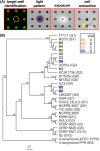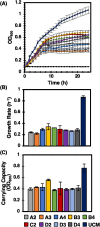Photo-addressable microwell devices for rapid functional screening and isolation of pathogen inhibitors from bacterial strain libraries
- PMID: 38434239
- PMCID: PMC10907074
- DOI: 10.1063/5.0188270
Photo-addressable microwell devices for rapid functional screening and isolation of pathogen inhibitors from bacterial strain libraries
Abstract
Discovery of new strains of bacteria that inhibit pathogen growth can facilitate improvements in biocontrol and probiotic strategies. Traditional, plate-based co-culture approaches that probe microbial interactions can impede this discovery as these methods are inherently low-throughput, labor-intensive, and qualitative. We report a second-generation, photo-addressable microwell device, developed to iteratively screen interactions between candidate biocontrol agents existing in bacterial strain libraries and pathogens under increasing pathogen pressure. Microwells (0.6 pl volume) provide unique co-culture sites between library strains and pathogens at controlled cellular ratios. During sequential screening iterations, library strains are challenged against increasing numbers of pathogens to quantitatively identify microwells containing strains inhibiting the highest numbers of pathogens. Ring-patterned 365 nm light is then used to ablate a photodegradable hydrogel membrane and sequentially release inhibitory strains from the device for recovery. Pathogen inhibition with each recovered strain is validated, followed by whole genome sequencing. To demonstrate the rapid nature of this approach, the device was used to screen a 293-membered biovar 1 agrobacterial strain library for strains inhibitory to the plant pathogen Agrobacterium tumefaciens sp. 15955. One iterative screen revealed nine new inhibitory strains. For comparison, plate-based methods did not uncover any inhibitory strains from the library (n = 30 plates). The novel pathogen-challenge screening mode developed here enables rapid selection and recovery of strains that effectively suppress pathogen growth from bacterial strain libraries, expanding this microwell technology platform toward rapid, cost-effective, and scalable screening for probiotics, biocontrol agents, and inhibitory molecules that can protect against known or emerging pathogens.
© 2024 Author(s).
Conflict of interest statement
R.R.H. and T.G.P. have a patent on this technology (U.S. Patent No. 11,235,330).57 The other authors have no conflicts to disclose.
Figures





Similar articles
-
On Demand Release and Retrieval of Bacteria from Microwell Arrays Using Photodegradable Hydrogel Membranes.ACS Appl Bio Mater. 2019 Jan 22;2(1):266-276. doi: 10.1021/acsabm.8b00592. Epub 2019 Jan 4. ACS Appl Bio Mater. 2019. PMID: 35016349
-
Simultaneous Discovery of Positive and Negative Interactions Among Rhizosphere Bacteria Using Microwell Recovery Arrays.Front Microbiol. 2021 Jan 5;11:601788. doi: 10.3389/fmicb.2020.601788. eCollection 2020. Front Microbiol. 2021. PMID: 33469450 Free PMC article.
-
Photodegradable Hydrogels for Rapid Screening, Isolation, and Genetic Characterization of Bacteria with Rare Phenotypes.Biomacromolecules. 2020 Aug 10;21(8):3140-3151. doi: 10.1021/acs.biomac.0c00543. Epub 2020 Jul 6. Biomacromolecules. 2020. PMID: 32559368 Free PMC article.
-
High impact technologies for natural products screening.Prog Drug Res. 2008;65:175, 177-210. doi: 10.1007/978-3-7643-8117-2_5. Prog Drug Res. 2008. PMID: 18084916 Review.
-
Pseudomonas savastanoi pv. savastanoi: some like it knot.Mol Plant Pathol. 2012 Dec;13(9):998-1009. doi: 10.1111/j.1364-3703.2012.00816.x. Epub 2012 Jul 17. Mol Plant Pathol. 2012. PMID: 22805238 Free PMC article. Review.
Cited by
-
A digital plating platform for robust and versatile microbial detection and analysis.Sci Rep. 2025 Jul 13;15(1):25301. doi: 10.1038/s41598-025-11525-6. Sci Rep. 2025. PMID: 40653544 Free PMC article.
References
-
- Chaloner T. M., Gurr S. J., and Bebber D. P., Nature Climate Change 11(8), 710–715 (2021). 10.1038/s41558-021-01104-8 - DOI
Grants and funding
LinkOut - more resources
Full Text Sources
